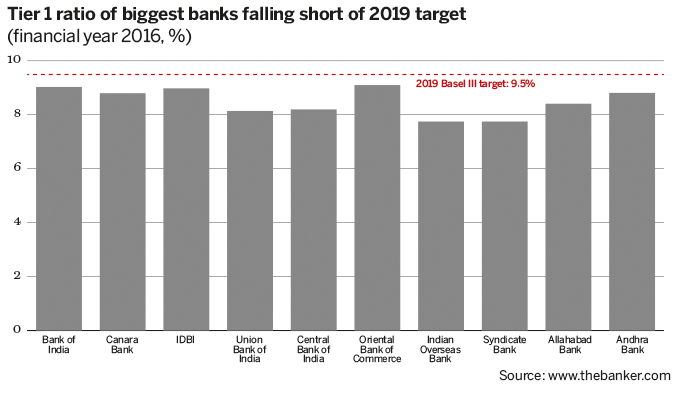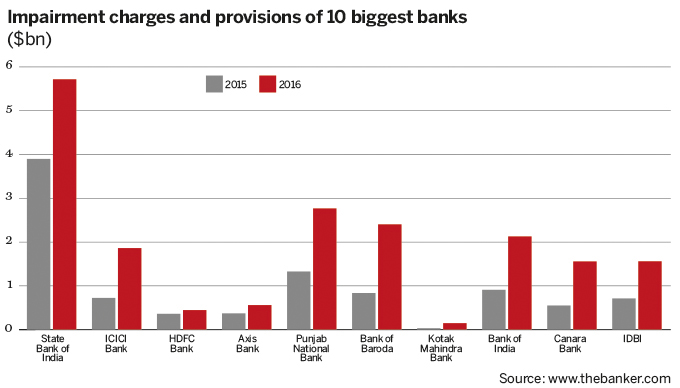India’s lenders have started the painful process of reclassifying impaired assets. Danielle Myles looks at their progress so far, and at those tackling the biggest capital shortfalls.
India is among the world’s fastest growing large economies, and within the next five years is projected to have a bigger population than any other country. Yet in general, its banking sector has failed to keep pace. Many of its state-run lenders, which own about 75% of the country’s banking assets, are facing major capital shortfalls as they enter the final stretch of Basel III’s transition period.
By April 2019, Indian banks must have a minimum capital-to-risk-weighted assets ratio of 11.5%, a Tier 1 capital ratio of 9.5% and common equity Tier 1 (CET1) ratio of 8%. Since 2011, the federal government has injected more than Rs83,600 crore ($12.42bn) into state lenders, in an effort to stave off broader economic problems. In the 2017-18 budget, announced on February 1, it committed another Rs100bn.
Capital conundrums
These measures have brought India’s ailing public banks closer to their regulatory requirements, but as of July 2016 Fitch estimated that the sector as a whole needed $90bn in additional capital to meet fully loaded Basel III targets. The rating agency said $45bn is needed for CET1, with additional Tier 1 making up the bulk of the remainder. Tier 1, it seems, is posing a bigger problem than Tier 2 capital buffers.
Data collected by The Banker reveals that as of April 2016, 17 of India’s 30 biggest banks (measured by Tier 1 capital) have Tier 1 ratios below the 9.5% target for 2019. All of them are state controlled and the list includes lenders such as Bank of India, Canara Bank and IDBI. State Bank of India, the country’s biggest bank, just exceeds the target, with a 9.87% ratio.
In March 2016, India’s central bank (the Reserve Bank of India, or RBI) expanded the pool of items that can be classified as Tier 1 capital, which automatically boosted banks’ capital ratios. This helped 15 of the 17 banks falling below the 9.5% threshold to increase their Tier 1 capital ratio between 2015 and 2016. The exceptions were Corporation Bank and UCO Bank, which dropped from 8.08% to 7.97% and 9.05% to 7.63%, respectively.
Biting the bullet
Banks are also undertaking some self-help measures. Following the RBI’s instruction in 2015 to clean up their balance sheets, lenders have begun to address non-performing loans (NPLs) and otherwise impaired assets building up on their books. This is revealed by changes in the biggest 10 banks’ impairment charges and provisions (ICP) – this is the loss recognised on the loan book every year to reflect the estimated value of loans and other assets, given they will not all be repaid, or not on the terms initially agreed.
The ICP of this sample more than doubled between 2015 and 2016, growing from $9.73bn to $19.16bn. In previous years their aggregate ICP fluctuated between $6.56bn and $8.67bn. Between 2015 and 2016, HDFC showed the smallest increase of 23.2%, while Kotak Mahindra’s grew 351% (although it started from a low base of $33m). The average NPL ratio of this group also nearly doubled between 2015 and 2016, growing from 3.765% in 2015 to 7.335%, while in 2014 it was a steady 3.06%.
These measures are hitting short-term profitability. The ICP of the top 10 banks amounted to 37.68% of their 2016 operating income. In 2015, that figure was 19.18%. However, it has also sparked speculation that India’s banks are starting the long process of recognising their non-performing assets and regenerating their loan books. Their next annual reports, due out in May, might offer more clues as to whether this really is the start of a turnaround.
All data sourced from www.thebanker.com.




